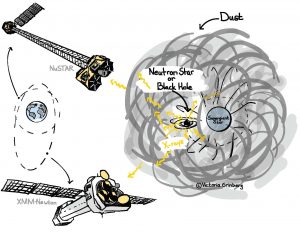Mysterious binary star system in space

The researchers observed the system simultaneously with two X-ray satellites. (Illustration: Victoria Grinberg)
Binary stars are well known to astrophysicists. One stellar double-act in particular has drawn their attention, as part of the X-ray radiation that binary star systems usually emit is missing, and the x-rays it did emit seemed to have strange properties. A research team led by FAU observed a binary star system using X-ray satellites to find some answers. Their results were published in the journal ‘Astronomy and Astrophysics’.
Binary star systems are not unusual in space. Even if like IGR J16318-4848, located in one of the spiral arms of our galaxy, one of the partners consists of a neutron star, the ultra-compacted remains of a stellar corpse. Its partner appears to be similarly exotic – a supergiant star that is several times the mass of our sun. On top of that, this monstrous cosmic litterbug blasts out vast amounts of iron into space. ‘Usually, we can detect a broad spectrum of soft and hard X-rays from such systems,’ explains Prof. Dr. Jörn Wilms from the Astronomical Institute of FAU in the Dr. Karl Remeis Observatory in Bamberg. But this system proved a tough nut to crack for astrophysicists not only because the entire soft X-ray radiation was missing but also because the hard X-rays have very surprising properties. Jörn Wilms, his doctoral candidate Ralf Ballhausen and a research team from Germany, the Netherlands, Spain and the USA were only able to solve this problem with the help of two X-ray satellites and computer models, which they used to simulate this mysterious binary system.
Further information
- Full FAU press release (also available in German)
- NuSTAR press release
- Original publication: Dust and gas absorption in the high mass X-ray binary IGR J16318−4848
For further information please contact:
Ralf Ballhausen
Ralf.Ballhausen@sternwarte.uni-erlangen.de
+49 951 95222 44
Jörn Wilms
Joern.Wilms@sternwarte.uni-erlangen.de
+49 951 95222 13





